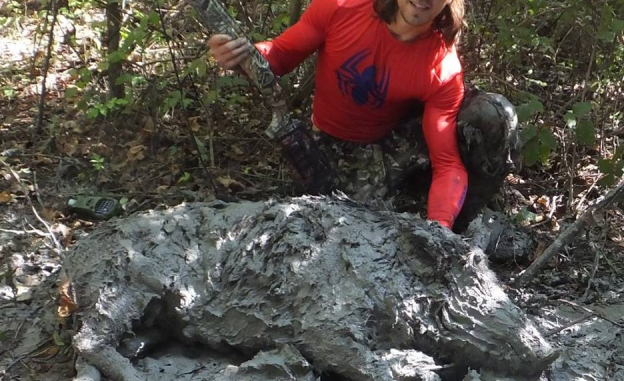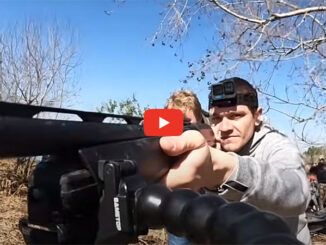
Ultra-marathon hunting/training regimen puts lots of pork in the freezer
This season I had a mission to fill my freezers by stalking hogs to help train for ultra-marathons. It’s been a major success so far, as I harvested 31 pigs in 18 days of hunting on R. K. Yancey Wildlife Management Area and Bayou Cocodrie National Wildlife Refuge. I used small game-sized tungsten ammo in my single shot and over/under 12-gauge shotguns for 25 of the pigs, my new crossbow for three and my recurve bows for the remaining three.
Anyone can fill their freezers with pork, but to get that many hogs it takes time and effort few are willing to put in. To prepare for a 100-mile ultra-marathon, I figured walking in the woods all day long and hauling out backpacks full of pork was the perfect training for the race. Over those first few weeks, I hiked around 150 hours and covered over 300 miles in the heat, with multiple layers of clothes to help keep the clouds of mosquitos from draining me dry.
The Tungsten Super Shot ammo is costly at $10 a shell, but it packs a huge punch that’s nearly twice as powerful as similar-sized lead. The BB shot will go completely through a big boar within 40 yards, whereas steel BBs will barely penetrate the hide at 20 yards. I only lost two big boars all month. One I shot with cheaper shells; the other was a longer shot on a moving boar. I could’ve easily taken twice as many pigs, as I saw hundreds during my hunts. However, I rarely take shots over 30 yards because I like to know my expensive ammo will result in an ice chest full of pork.
The smackdown began on the Sunday after arriving home from my Colorado hunting trip. Teal season had just opened, and I was testing out the heaviest Tungsten Super Shot loaded by Apex Ammunition for the first time on hogs. That morning I stalked a pack of hogs to within 20 yards and lined up two pigs at first light. The No. 2 TSS took both 70-pound hogs in one shot.
Later in the week, I shot three more pigs on a Wednesday, including a nice boar using BB TSS shot. On that day I was scouting for alligators to help a friend out who got picked for lottery tags when I stepped on a big 8-foot gator that exploded out of the duckweed and nearly bit my leg off in only 15 inches of water on video. The video of several of the hog kills and gator attack can be found here.
The next weekend started with me taking a big 200-pound boar using Dead Coyote shells on a close shot. The hog still ran 200 yards and died in a muddy wallow where he was completely covered in slop. My wife videoed me getting full of mud myself, taking 10 minutes to roll him out to clean.
I clean all my pigs in the woods in minutes using a Havalon Barracuda knife, latex gloves and a heavy-duty ice bag. The razor-sharp changeable 4 ¾-inch blades work better than any knife I’ve ever used. The meat is ready for the pot as soon as I arrive back at the truck. With all the pork I harvest, I eat the leanest pieces and share the rest with friends and family. Also, I feed my dogs boiled pork almost daily all year long to avoid feeding them chemical-ridden store-bought dog food.
I will not be using any weaker tungsten shells, which are similar in density to lead on large boars. The penetration was poor even on the close 15 yard shot on that 200-pounder. Only a few of the 51 T-shot pellets that hit the hog actually made it into the vitals, and none made it through the shoulder plate.
That weekend my brother and two younger cousins joined in on the action at some of my favorite spots. On his 20th birthday weekend, my cousin went on his first-ever public land hunt and took out four pigs in his first morning. He got a big sow and chased down three smaller ones after watching my previous videos on stalking.
Later that evening, he shot another three, getting the big sow first then two 40-pounders barefooted in a muddy field. My brother also scored, getting a nice 80-pound sow. I shot another hog myself after crawling on my belly to line up a shot in the thick brush: a 150-pound sow with my primitive 4.8-pound single-shot 12-gauge.
I bought the tiny shotgun to use for primitive deer season, and have an ultra-light portable weapon to take on lengthy hunting days. It has a fixed modified choke that shoots great, but my heavy 2.25-ounce shells produce upwards of 90 pounds of recoil. For reference, my .270 pushes back about 16 pounds of recoil, and my hard-kicking .45-70 rifles usually recoil in the mid-30s. My ultra-light 6.1-pound CZ over-and-under and the 4.8-pound Legacy pointer will pound not only the hogs, but your shoulder, too!
On Sunday, I downed one smaller pig in the morning, and my cousin knocked down another one, too. It was a successful weekend to say the least, but my other cousin lost one big boar. I went to look for it with my wife joining in for hours on my way home and jumped it. I had no luck getting a shot off on that pig, but my wife spotted some others. I stalked them for 20 minutes crossing a pond and got all three pigs with my Tristar magnum over-and-under with No. 7 TSS 2.5-ounce turkey shells.
September ended with a hog count of 11 pigs for myself, and another 11 taken by my friends and family. I thought I may have overdone the training hiking just several days before my ultra-marathon on Sept. 30th, but those hot grueling hunts were just what I needed to get my edge.
I ran the Children of the Cane 100-mile race on a hot 90 degree day on a near shadeless course, winning in a time of 19 hours and 40 minutes to become Louisiana’s fastest 100 mile runner on a full length course in my first attempt at the distance. I ran nearly all of it, including the final 30 miles nonstop using my dogs to pace me to hold off a very tough runner who finished close behind me. I won the coveted shiny sub-20 hour belt buckle, for which ultra-runners practically kill themselves to obtain.
The second place guy I had battled all day long didn’t walk a step until Mile 97. He had passed me up at Mile 60 after being on my tail all day. I took back the lead at Mile 82 never to relinquish it. In most 100 milers, at Mile 62 pacers are allowed, which help tremendously — and my wife and dogs gave me the mental boost it takes to finish these events. Most of the competitors had a team of helpers, but I ran only using my dogs as emotional support since we train all year long together.
The limitless potential of the human body is truly amazing, and it’s my hardcore style of Louisiana hunting that helps give me the edge over the other elite runners I battle who don’t take part in such endeavors. It was my fourth straight ultra-marathon victory, and I can’t decide what I love more: big game hunting or those crazy trail runs. I encourage any hunter out there to try a fun trail race of any distance, as the training will enhance your endurance to hunt deeper and harder than ever before.
Part Two of the hog smackdown will be released soon, which will cover what happened the day after the 100-mile race when bow season opened. It also will feature some of the best hunting footage I’ve ever filmed.
Most people rest for days and weeks after ultra-marathons, but hunting in 90-degree weather is what I love — and I didn’t limp nine grueling hours with my recurve and crossbow in the hot woods that next day for nothing. Stay tuned.

